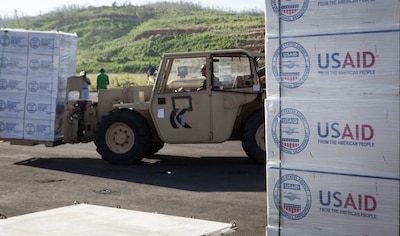By Navy Petty Officer 2nd Class Sean Gallagher,
Expeditionary Strike Group Three
SAN DIEGO, Oct. 23, 2017 — The Navy’s Expeditionary Strike
Group 3 and the Marine Corps’ 1st Marine Expeditionary Brigade kicked off the
joint amphibious exercise Dawn Blitz here Oct. 20.
Dawn Blitz is an annual scenario-driven amphibious exercise
designed to train and integrate the staffs of ESG-3 and 1st MEB. It provides
the realistic, relevant training necessary for the effective global crisis
response expected of the Navy and Marine Corps team.
The exercise takes place at sea off the coast of Southern
California and will involve participation from ships homeported at Naval Base
San Diego including the amphibious assault ship USS Essex, the amphibious
transport dock USS Anchorage, the amphibious dock landing ship USS Rushmore and
the guided missile destroyer USS Wayne E. Meyer. These ships will integrate
with 1st MEB and Coastal Riverine Group 1 to demonstrate how U.S. forces are
capable, interoperable and deployable on short notice while being fully combat
ready.
“Dawn Blitz 2017 is an excellent opportunity to
operationalize concepts the Navy and Marine Corps services have been discussing
for some time,” said Navy Cmdr. Matthew Hoekstra, director of maritime
operations for ESG-3 and lead exercise planner for Dawn Blitz. “While others
continue to talk, wargame or tabletop future concepts, we are executing with
live forces afloat and ashore.”
The exercise consists of various wartime events leading to
the deployment of U.S. and allied forces against a hypothetical enemy. Forces
will plan and execute an amphibious assault, engage in live-fire events, and
establish expeditionary advanced bases in a land and maritime threat
environment to improve naval amphibious core competencies.
Crucial Joint Training
“Dawn Blitz provides crucial training for our Navy-Marine
Corps team,” said Navy Rear Adm. Cathal O'Connor, the commander of ESG-3. “The
capability to conduct prompt and sustained amphibious operations anywhere in
the world is essential to our Navy and our nation. The amphibious force's
capabilities range from high-end warfighting to the disaster response
capabilities our East Coast sailors and Marines are demonstrating today.”
“Since this is a multinational exercise,” he said, “working
with our international partners helps foster and sustain cooperative
relationships that enhance regional security, stability and prosperity around
the globe.”
Dawn Blitz 2017 builds upon previous iterations of the
exercise and affords the Navy and Marine Corps team the opportunity to capture
lessons learned, develop amphibious staff expertise and test new capabilities
and equipment for the future fight.
New to this year’s exercise is the integration of the F-35B
Lighting II joint strike fighter and the High Mobility Artillery Rocket System
to conduct a sea-based strike. This will allow commanders to validate a
capability with platforms not traditionally used at this level.
Additionally, demonstration of the composite warfare
construct and other command and control arrangements will help to promote unity
of effort in littoral warfare.
"Our experiment in command and control structure is
designed to provide the commander with greater flexibility and speed to employ
assigned forces,” Hoekstra said. “The amphibious force has always been the
vanguard of naval power in these qualities."
The Navy and Marine Corps enjoy a close working relationship
based on past tradition, present requirements and future necessity to project
power ashore. Leadership of both services share a common goal to refine and
strengthen core amphibious competencies critical to maritime power projection.
Experiment, Refine Concepts
"Dawn Blitz 17 is an invaluable opportunity for I
Marine Expeditionary Force and the 1st MEB to experiment with advanced maritime
and naval warfighting concepts, as well as refine existing tactics, techniques
and procedures,” said Marine Corps Lt. Col. Thomas Savage, the 1st MEB
operations officer. “The exercise also reinforces the strong and enduring
relationships between U.S. Third Fleet, Expeditionary Strike Group 3, I MEF and
1st MEB.”
An infantry company from the Japan Ground Self-Defense Force
will also participate along with observers from Chile, Peru, Colombia and
Mexico. The coordination with international partners will help foster and
maintain critical relationships to preserve peace and promote stability.
This year’s exercise is an opportunity to meet the
challenges of future conflicts, overseas contingency operations, humanitarian
assistance and disaster response and national defense. The lessons learned are
expected to improve the lethality and mission effectiveness of U.S. maritime
forces.
“The experimentation results from Dawn Blitz 17 directly
affect both the Navy and Marine Corps' future lethality and ability to fight
and win in the future operating environment,” Savage said. “Although the path
ahead may be a challenging one as we seek to operationalize concepts, shape
force capabilities, and integrate future systems, the lessons learned leading
up to and during exercise execution promise the naval force sound security as one
of our nation's principal means to project power from the sea to all domains of
the battlefield."









